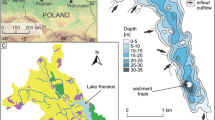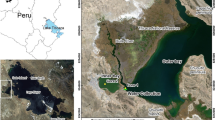Abstract
Post-isolation (9,600 year BP) sedimentology in Lake Pyhäjärvi, Finland, was studied using sub-bottom echo-sounding and sediment coring. The sediment sequence appeared in the echo-sounding profiles as two sections: (1) a lower section of homogenous, light grey gyttja clays, and (2) an upper section with dark layers of mainly clay gyttjas and gyttjas, here referred to as C_gyttja. We investigated the thickness and volume of sediments as well as their morphology and areas of accumulation. Approximately 77 % of the lake represents areas of accumulation, containing 34 and 1.3 million tons of dry matter and carbon, respectively. Spatial variability in sedimentological properties indicates that accumulation in the Kirkkoselkä sub-basin was focused into the deepest areas since lake isolation. In the Isoselkä sub-basin, however, accumulation was focused partially onto the flanks of the depression, whereas the deepest parts (23–27 m) of the sub-basin represent erosional areas. There appears to have also been sediment re-suspension and re-deposition, as indicated by erosion surfaces. This, combined with dune-like bottom morphology in the accumulation areas, provides evidence for the role of wind-driven bottom currents on sedimentation dynamics in the Isoselkä sub-basin. Increases in Cu and Zn concentrations, driven by Pyhäsalmi mining activities, were used as a geochemical marker for recent sedimentation (RS) between 1966 and 2008. As a consequence of wind-driven bottom currents, 60 % of the metals accumulated in the Kirkkoselkä sub-basin and 40 % accumulated in the Isoselkä sub-basin. There is a spatial correlation between amounts of C_gyttja and RS. In the middle of dune-like C_gyttja formations in the Isoselkä sub-basin, the RS grain size is smaller than in other areas. Variations in RS are greatest along the borders of the accumulation area, likely a consequence of bottom currents in those areas.







Similar content being viewed by others
References
Airiola S, Sunnari H, Heikkinen M-L, Tolkkinen M (2007) Junttiselän kuormittajat. In: Heikkinen M-L, Väisänen T (eds) Pyhäjärven Junttiselän tila ja kunnostusmahdollisuudet. Pohjois-Pohjanmaan ympäristökeskuksen raportteja 7
Anselmetti FS, Ariztegui D, de Batist M, Gebhardt AC, Haberzettl T, Niessen F, Ohlendorf C, Zolitschka B (2009) Environmental history of southern Patagonia unravelled by the seismic stratigraphy of Laguna Potrok Aike. Sedimentology 56:873–892
Gilli A, Ariztegui D, Anselmetti F, McKenzie JA, Markgraf V, Hajdas I, McCulloch RD (2005) Mid-Holocene strengthening of the southern Westerlies in South America—sedimentological evidences from Lago Cardiel, Argentina (498S). Global Planet Change 49:75–93
Gregow H, Venäläinen A, Laine M, Niinimäki N, Seitola T, Tuomenvirta H, Jylhä K, Tuomi, T, Mäkelä A (2008) Vaaraa aiheuttavista sääilmiöistä Suomen muuttuvassa ilmastossa. Ilmatieteen laitos. English summary: Danger-causing weather phenomena in changing Finnish climate. Finnish Meteorological Institute. Reports no. 2008: 3, p 106
Håkanson L (1977) The influence of wind, fetch, and the water depth on the distribution of sediments in Lake Vänern, Sweden. Can J Earth Sci 14:397–412
Håkanson L, Jansson M (1983) Principles of lake sedimentology. Springer, Berlin, p 316
Heikkinen M-L, Väisänen T (2007) Pyhäjärven Junttiselän tila ja kunnostusmahdollisuudet. Pohjois-Pohjanmaan ympäristökeskuksen raportteja 7, p 78
Helovuori O (1979) Geology of the Pyhäsalmi ore deposit Finland. Econ Geol 74:1084–1101
Horppila J, Niemistö J (2008) Horizontal and vertical variations in sedimentation and resuspension rates in a stratifying lake—effects of internal seiches. Sedimentology 55:1135–1144
Johansson H, Brolin A, Håkansson L (2007) New approaches to the modelling of lake basin morphometry. Environ Model Assess 12:213–228
Jurvansuu T, Pasanen P, Heikkilä K, Aunola A, Mäki T, Erkkilä E, Lappalainen P, Niiranen S, Lähteenmäki S, Mustikkamäki UP, Tolonen S, Lehtinen I, Winblad I (2003) Pyhäsalmen kaivos. The Pyhäsalmi mine. In: Tulkku J (ed) Ruotasen savut. Kylä ja kaivos. Ruotasen maamiesseura ry, Gummerus Kirjapaino Oy, Jyväskylä. ISBN 952-91-5698-7, pp 361–489 (In Finnish)
Koljonen T (1992) Suomen geokemian atlas. Osa 2: Moreeni = The Geochemical Atlas of Finland. Part 2: Till. Espoo: Geologian tutkimuskeskus. 218 p + 9 app maps
Lesht B, Hawley N (1987) Near-bottom currents and suspended sediment concentration in southeastern Lake Michigan. J Great Lakes Res 13:375–386
Lintinen P (1995) Origin and physical characteristics of till fines in Finland. Geological survey of Finland, Bulletin 379, p 83
Luukas J (1997) Geology and mineral deposits of the central Ostrobothnia. In: Weihed P, Mäki T (eds) Volcanic hosted massive sulfide deposits and gold deposits in the Skellefte district, Sweden and Western Finland. 4th biennial SGS meeting. August 11–13, 1997, Turku, Finland. Excursion guidebook A2
Mäkinen J (2003) Natural arsenic and lead concentration levels in Finnish lake sediments. In: Honkanen JO, Koponen PS (eds) Sixth finnish conference of environmental sciences. Joensuu, May 8–9, 2003. Current perspectives in environmental science and technology. Finnish society for environmental sciences, pp 84–87
Mäkinen J (2011) Pyhäsalmen Pyhäjärven sedimentaatiotutkimukset 2006–2010. Geological survey of Finland. Report. p 52. http://arkisto.gtk.fi/2011/7_2011.pdf
Mäkinen J, Lerssi J (2007) Characteristics and seasonal variation of sediments in Lake Junttiselkä, Pyhäsalmi, Finland. Mine Water Environ 26:217–228
Mäkinen J, Pajunen H (2005) Correlation of carbon with acid-soluble elements in Finnish lake sediments : two opposite composition trends. Geochem Explor Environ Anal 5:169–181
Mikkola M, Pakkala J (1997) Keski-Pohjanmaan vesistöjen tila ja vesiensuojelun kehittämissuunnitelma. Keski-Pohjanmaan ympäristökeskus, Alueelliset ympäristöjulkaisut, p 27
Ojala AEK, Tiljander M (2003) Testing the fidelity of sediment chronology: comparison of varve and paleomagnetic results from Holocene lake sediments from central Finland. Quat Sci Rev 22:1787–1803
Pajunen H (2004) Järvisedimentit kuiva-aineen ja hiilen varastona. Summary: lake sediments as a store of dry matter and carbon. Geological survey of Finland, Report of investigation 160, p 308
Räisänen M-L, Mäkinen J (2007) Pyhäjärven Junttiselän veden ja pintasedimenttien vuodenaikainen koostumusvaihtelu, 2005–2007. Geologian tutkimuskeskus, Itä-Suomen yksikkö S49/0000/2007/44, http://arkisto.gtk.fi/s49/s_49_0000_2007_44.pdf
Renberg I, Wik-Persson M, Emteryd O (1994) Pre-industrial atmospheric lead contamination detected in Swedish lake sediments. Nature 368:323–326
Rowan DJ, Cornett RJ, King K, Risto B (1995) Sediment focusing and 210Pb dating: a new approach. J Paleolimnol 13:107–118
Saarinen T (1994) Palaeomagnetic study of the Holocene sediments of Lake Päijänne (Central Finland) and Lake Paanajärvi (North-West Russia). Geological survey of Finland, Bulletin 376, p 87
Saarnisto M (1970) The late Weichselian and Flandrian history of the Saimaa Lake Complex. Societas Scientiarum Fennica, Commentationes Physico-Mathematicae, 37, p 107
Saltikoff B, Puustinen K, Tontti M (2006) Metallogenic zones and metallic mineral deposits in Finland: explanation to the Metallogenic map of Finland. Geological survey of Finland special paper 35, p 66
Snowball I, Zillén L, Ojala A, Saarinen T, Sandgren P (2007) FENNOSTACK and FENNORPIS : varve dated Holocene palaeomagnetic secular variation and relative palaeointensity stacks for Fennoscandia. Earth Planet Sci Lett 255:106–116
Thompson R, Oldfield F (1986) Environmental magnetism. Allen and Unwin, London, p 227
Weyhenmeyer GA, Håkanson L, Meili M (1997) A validated model for daily variations in the flux, origin, and distribution of settling particles within lakes. Limnol Oceanogr 42:1517–1529
Author information
Authors and Affiliations
Corresponding author
Rights and permissions
About this article
Cite this article
Mäkinen, J., Ojala, A.E.K. Sedimentation dynamics and metal loading in Lake Pyhäjärvi, Finland. J Paleolimnol 50, 1–13 (2013). https://doi.org/10.1007/s10933-013-9688-8
Received:
Accepted:
Published:
Issue Date:
DOI: https://doi.org/10.1007/s10933-013-9688-8




